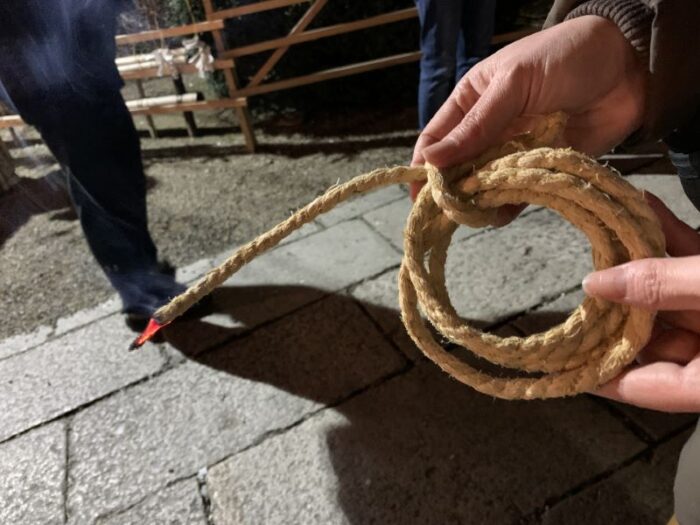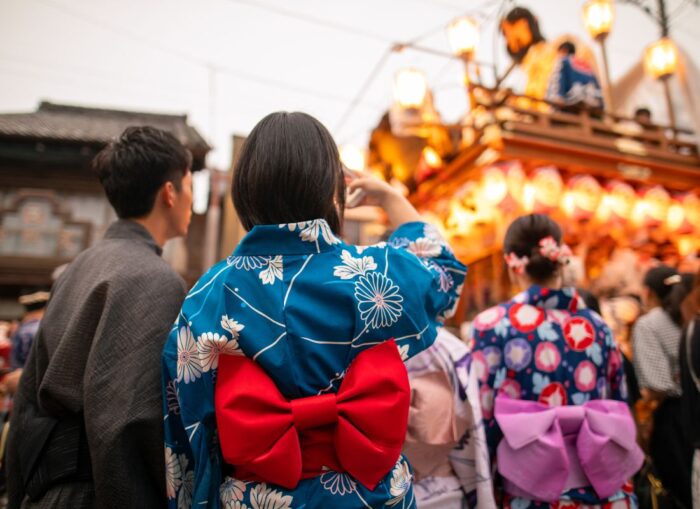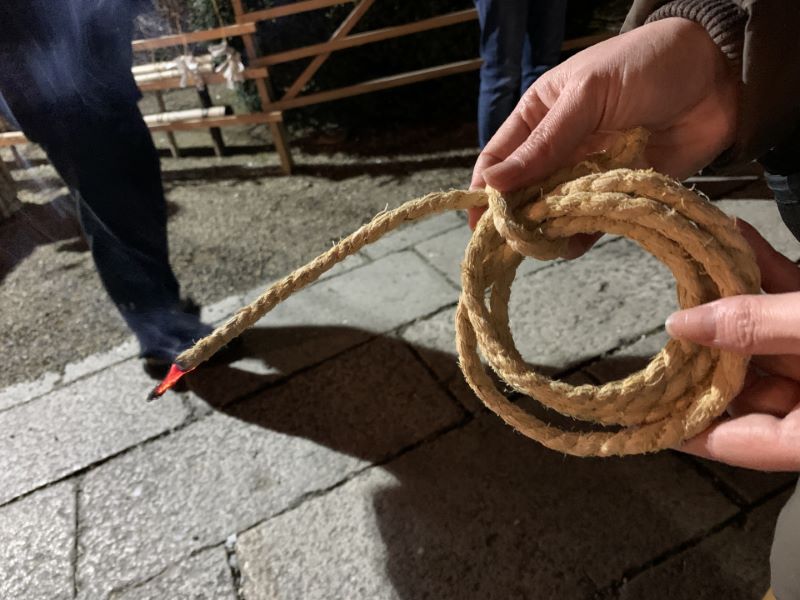Every year on New Year’s Eve, the Yasaka Shrine in Kyoto comes alive with the vibrant and enchanting festival of Okera Mairi. This late-night celebration is a powerful tradition that aims to cleanse negative energies and usher in good fortune for the coming year.

Attendees swing lit bamboo ropes, keeping the flames alive as they participate in this ancient ritual. Bonfires are set ablaze with the roots of the sacred Okera tree, and the flames are used to ignite toro lanterns at the shrine.
With its rich history and cultural significance, Okera Mairi at Yasaka Shrine is a captivating experience that showcases the beauty and spirituality of Kyoto’s Higashiyama district.
Key Takeaways
- Okera Mairi is an annual late-night festival held at Yasaka Shrine in Kyoto.
- The festival involves the symbolic burning of medicinal herbs to cleanse negative energies and bring good fortune for the coming year.
- Attendees swing lit bamboo ropes to keep the flames alight and set ablaze the roots of the Okera tree in bonfires.
- Yasaka Shrine, also known as Gion-san, is dedicated to the god Susanoo no Mikoto and is a highly revered and popular destination in Kyoto’s Higashiyama district.
The History of Okera Mairi at Yasaka Shrine
The history of Okera Mairi at Yasaka Shrine dates back to ancient times and has been celebrated annually as a late-night festival on New Year’s Eve.
This unique tradition involves the burning of medicinal herbs and swinging lit bamboo ropes to cleanse negative energies and bring good fortune for the coming year.
The roots of the Okera tree are set ablaze in bonfires, and the flames are used to ignite toro lanterns at Yasaka Shrine.
Attendees then light their bamboo ropes from these lanterns, creating a sacred flame that is used to light candles and prepare zoni soup.
The festival starts at 7 p.m. on December 31 and continues until 5 a.m. on January 1.
This ancient tradition has continued to captivate and engage people for generations, offering a truly special way to welcome the New Year.
The Significance of Burning Medicinal Herbs
Visitors to the annual Okera Mairi festival at Yasaka Shrine in Kyoto experience the powerful significance of igniting and cleansing with the smoke of medicinal plants. This tradition holds deep spiritual meaning for the attendees, as they believe that the smoke from burning these herbs purifies their bodies and minds, warding off negative energies and bringing good fortune for the coming year.
As the flames dance and the smoke fills the air, the atmosphere becomes charged with a sense of renewal and hope. People participate by swinging lit bamboo ropes, keeping the fires alive and vibrant.
The Okera Mairi festival is a unique opportunity to connect with ancient traditions and tap into the healing properties of these medicinal plants. It is a truly transformative experience that leaves a lasting impression on all who take part.
The Ritual of Swinging Lit Bamboo Ropes
Participants in the annual Okera Mairi festival at Yasaka Shrine in Kyoto actively engage in the ritual by enthusiastically swinging ropes illuminated by the flickering glow of lit bamboo.
This unique tradition, held on New Year’s Eve, involves the symbolic burning of medicinal herbs to cleanse negative energies and bring good fortune for the coming year. As attendees gather around bonfires, they swing the lit bamboo ropes to keep the flames alive, creating a mesmerizing sight.
The roots of the Okera tree are set ablaze, and the flames are used to ignite toro lanterns at Yasaka Shrine. The attendees then light their bamboo ropes from these lanterns, using the sacred flame to light candles and prepare zoni soup.
The enthusiasm and energy displayed by the participants make this ritual an unforgettable experience for all involved.
Lighting the Torch: Bonfires and Okera Tree Roots
Illuminated by the flickering glow of lit bamboo, attendees at the annual Okera Mairi festival actively engage in the ritual of swinging ropes, keeping the flames alive as they gather around bonfires. This captivating tradition holds a special significance, evoking a range of emotions in those who participate.
Awe: As the flames dance and illuminate the night, the attendees are filled with a sense of wonder and reverence, marveling at the power and beauty of the fire.
Excitement: The crackling sound of burning Okera tree roots and the warmth of the bonfires create an atmosphere of excitement and anticipation, heightening the festival’s energy.
Connection: Swinging the lit bamboo ropes together fosters a strong sense of community and unity among the participants, as they work together to keep the flames alive.
Hope: The fires, believed to bring good fortune for the coming year, instill a sense of hope and optimism in the hearts of those present, as they look forward to a prosperous future.
In this ancient tradition, the act of lighting the torch not only represents the physical act of keeping the flames alive but also symbolizes the collective desire for a bright and auspicious year ahead.
Igniting the Flame: Toro Lanterns and Sacred Fire
As the festival progresses, the attendees gather around the toro lanterns, using the sacred flame from the bonfires to ignite the candles and prepare zoni soup.
The toro lanterns, with their warm glow, create a mesmerizing ambiance, illuminating the night sky. The flickering flames dance in the cool air, casting a soft light on the faces of the people gathered. It is a moment of shared camaraderie and anticipation for the year ahead.
The sacred flame, believed to possess divine power, is carefully transferred from the bonfires to the lanterns, symbolizing the connection between the earthly and the spiritual realms. As the candles are lit, their gentle warmth fills the air, creating a comforting atmosphere.
The preparation of zoni soup, a traditional New Year’s dish, further strengthens the bond between the attendees and the festival’s ancient traditions.
From Lanterns to Candles: The Power of the Sacred Flame
The attendees gather around the toro lanterns, carefully transferring the sacred flame from the bonfires to ignite the candles and prepare zoni soup. As they light the candles, a sense of reverence fills the air, for the sacred flame holds immense power and significance. Here is how the flame is embraced:
- The flame, believed to cleanse negative energies, is passed from bonfires to toro lanterns.
- Attendees use the flame to light bamboo ropes, swinging them to keep the fire alive.
- This flame is used to ignite candles, symbolizing hope and purity.
- The sacred flame is utilized to prepare zoni soup, a traditional dish for the New Year.
With each action, the attendees honor the flame’s power, seeking blessings and good fortune for the coming year. It is a moment of connection, where the flame becomes a catalyst for renewal and hope.
The Schedule of Okera Mairi: New Year’s Eve Festivities
Visitors eagerly anticipate the late-night festivities of Okera Mairi, which commence at 7 p.m. on December 31 and conclude at 5 a.m. on January 1.
This unique New Year’s tradition takes place at Yasaka Shrine, also known as Gion-san, in Kyoto.
The festival involves the burning of medicinal herbs and swinging lit bamboo ropes.
As the clock strikes midnight, attendees gather around bonfires, setting ablaze the roots of the Okera tree.
The flames are then used to ignite the toro lanterns at the shrine.
Participants light their bamboo ropes from these lanterns, creating a sacred flame that is used to light candles and prepare zoni soup.
Okera Mairi is just one of the many celebrations held at Yasaka Shrine, which is revered among locals and attracts many visitors seeking blessings and expressing gratitude.
Yasaka Shrine: Gion-San and Its Cultural Importance
Gion-san, known as Yasaka Shrine, holds significant cultural importance in Kyoto’s Higashiyama district. This revered shrine is dedicated to Susanoo no Mikoto, a god believed to erase misfortune.
Here are four reasons why Yasaka Shrine is a must-visit destination in Kyoto:
- Historical Significance: The main shrine at Yasaka Shrine is recognized as a National Treasure, showcasing the rich history and architectural beauty of Japan.
- Popular Tourist Attraction: Yasaka Shrine counts among the most visited sights in Kyoto’s Higashiyama district, attracting locals and tourists alike.
- Power Spot for Beauty: The shrine houses Utsukushi-gozensha, a power spot believed to enhance beauty and radiance.
- Cultural Significance: Yasaka Shrine is not only famous for its New Year’s Eve festival, Okera Mairi, but also for Hatsumode, a highly revered and popular event where visitors seek blessings and express gratitude.
Visiting Yasaka Shrine is an opportunity to immerse oneself in the rich cultural heritage and spiritual traditions of Kyoto.
Utsukushi-gozensha: The Power Spot for Beauty
Utsukushi-gozensha at Yasaka Shrine is believed to enhance beauty and radiance, attracting many individuals seeking its power. This sacred spot holds a special significance for those who desire to enhance their physical appearance. People from all walks of life visit Utsukushi-gozensha in hopes of attaining a greater sense of beauty and allure.
The serene atmosphere of the shrine adds to the allure, creating a peaceful and tranquil environment for visitors to connect with their inner beauty. Many individuals come to Yasaka Shrine specifically to experience the transformative power of Utsukushi-gozensha and leave feeling refreshed and rejuvenated.
Whether seeking a boost in confidence or simply wanting to enhance their natural beauty, Utsukushi-gozensha offers a unique opportunity for individuals to embrace their inner radiance and leave with a renewed sense of self.
Beyond Okera Mairi: Other Celebrations at Yasaka Shrine

Yasaka Shrine hosts a highly revered and popular event called Hatsumode, where individuals seek blessings and express gratitude for the new year. This event offers a cultural and spiritual experience in Kyoto.
Here are four other celebrations that take place at Yasaka Shrine:
- Setsubun: On February 3rd, attendees throw roasted soybeans to ward off evil spirits and bring good luck for the year ahead.
- Gion Matsuri: This renowned festival occurs in July and is one of Japan’s most famous events. It features colorful processions, music, and traditional performances.
- Hanatoro: Held in March, this event illuminates the streets around Yasaka Shrine with thousands of lanterns, creating a magical atmosphere for visitors to enjoy.
- Aoi Matsuri: Taking place in May, this festival dates back over 1,400 years and showcases a grand procession of people dressed in ancient court costumes.
These celebrations add to the vibrant atmosphere and cultural significance of Yasaka Shrine throughout the year.
Frequently Asked Questions
How Long Has Okera Mairi Been Celebrated at Yasaka Shrine?
Okera Mairi has been celebrated at Yasaka Shrine for many years. This unique tradition involves burning herbs and swinging lit bamboo ropes to ward off bad luck and welcome good fortune for the new year.
What Is the Significance of the Okera Mairi Festival?
The significance of the Okera Mairi festival at Yasaka Shrine lies in its tradition of burning medicinal herbs to cleanse negative energies and swinging lit bamboo ropes to keep the flames alight, believed to bring good fortune for the coming year.
How Are the Bonfires and Okera Tree Roots Used in the Festival?
During the Okera Mairi festival at Yasaka Shrine, the bonfires and okera tree roots are used to ignite the flames. These flames are then used to light toro lanterns, bamboo ropes, candles, and prepare zoni soup.
Can You Explain the Ritual of Lighting the Torch Using Toro Lanterns and the Sacred Flame?
The ritual of lighting the torch at Okera Mairi involves using toro lanterns and a sacred flame. Attendees light the bamboo rope from the lanterns, which is then used to light candles and prepare zoni soup.
What Other Celebrations Take Place at Yasaka Shrine Besides Okera Mairi?
Besides Okera Mairi, Yasaka Shrine is known for Hatsumode, a highly revered and popular event where visitors seek blessings and express gratitude. It attracts over 1 million individuals and offers a cultural and spiritual experience in Kyoto.
Conclusion
In conclusion, Okera Mairi at Yasaka Shrine is a captivating and spiritually significant event. It brings people together to cleanse negative energies and welcome good fortune for the coming year. The tradition of burning medicinal herbs and swinging lit bamboo ropes creates a mesmerizing spectacle. The lighting of toro lanterns and the sacred flame adds a sense of reverence and spirituality.
Yasaka Shrine itself is a must-visit destination in Kyoto’s Higashiyama district. It has a National Treasure main building and cultural importance. Beyond Okera Mairi, the shrine offers various other celebrations and events. These showcase the rich traditions and beliefs of Japan.




